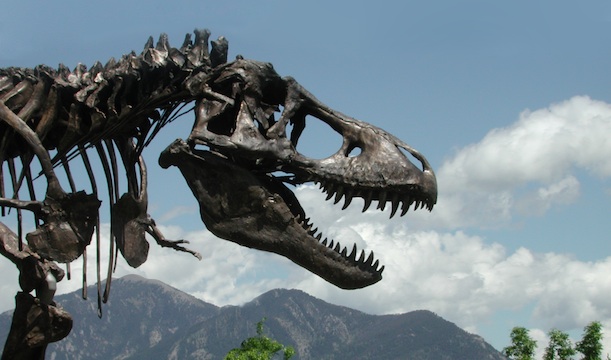About Deep Time: A Preview of the Natural History Museum’s Fossil Hall Renovation
The new Deep Time Hall will connect paleontology to modern life
/https://tf-cmsv2-smithsonianmag-media.s3.amazonaws.com/filer/20131029014041extinct-monsters-470.jpg)
“Times have changed,” reads a disclaimer at the Natural History Museum, “and so have the dates in many of our fossil displays.” This notice, accompanied by a revised geological timeline, is currently posted throughout the museum’s fossil halls. It’s a stopgap measure to update exhibitions that haven’t changed in 30 years—but it won’t be needed for much longer. The Natural History Museum is about to undergo a gut renovation that will not only update these exhibitions, but also transform their narrative of earth’s fossil record.
The “Deep Time” project is the largest and most complex renovation in the museum’s history. All of the current fossil exhibitions, including Life in the Ancient Seas, Dinosaurs and Ice Ages, will come down to make way for the Deep Time Hall, a thematic, rather than encyclopedic, timeline of life on Earth. This exhibition, slated to open in 2019, will illustrate the relevance of paleontology to modern life, portraying ancient plants and animals as interconnected parts of ecosystems and revealing a fossilized world just as complicated as ours.
“We study things like climate change and carbon dioxide in the past, extinction, things that are going on in the world today,” says Matt Carrano, lead curator of the Deep Time initiative. “It’s all of these big systems that work together. . . those are the systems that we are paying attention to in the present.”
The biggest change is chronological: the Deep Time story will run in reverse. Visitors entering the exhibition from the rotunda will start with the most recent past—the Ice Age, during which humans actually lived—and travel backward in time to the primordial Earth. In many museums, Carrano says, the prehistoric world feels like an “alien experience” and visitors “may as well be taking a spaceship to different planets.” Deep Time, on the other hand, will move from the familiar to the abstruse: “You have a house, you’ve taken it down and now you’re looking at the foundation—rather than you have a hole in the ground and you’re trying to tell people that there’ll be a house there later.”
The infrastructure of the gallery space will also receive its first makeover in more than a century. When the Natural History Museum first opened in 1910, the paleobiology wing consisted solely of the “Hall of Extinct Monsters,” little more than a trophy gallery for dinosaur fossils. Over the years, more and more exhibitions were tacked onto the space, resulting in the labyrinthine form of the fossil halls today. The renovation will remove the false walls subdividing the space and restore its original Beaux-Arts architecture. The new Deep Time Hall will be one cavernous, continuous gallery, with “display islands” that elaborate on specific themes.

A close-up of the skull of the “Wankel T. rex” skeleton installed in front of the Museum of the Rockies in 2001. The “Wankel T. rex,” one of the most complete T. rex skeletons ever discovered, has been transferred to the Smithsonian in a 50-year loan agreement with the Army Corps of Engineers. The fossil will be displayed in the Natural History Museum’s new dinosaur hall in 2019. Photo courtesy of Museum of the Rockies
Of course, no paleontology exhibit would be complete without a few dinosaurs, and the revamped space will display them to maximum effect. The fossil halls’ biggest draws, including the giant diplodocus on view and the Wankel T. rex on the way, will be placed in the center of the gallery so that visitors can see them all in one glance.
Other changes will be less noticeable, but more scientifically compelling. Carrano points to the current display of an allosaurus about to attack a stegosaurus: “What’s the point of showing that, besides the entertainment? We could talk about: What is it that predators do? What is it that herbivores do? Is that any different from today? Probably not. As dramatic as those animals are, they’re doing things that you can see happening out your window right now.” In the new exhibition, these creatures might represent predation or the relationship between species form and function. The work of the Deep Time team is as much about storytelling as it is about stage-setting for some of the Smithsonian’s best-loved fossils.
After the current fossil exhibitions go back into storage, a temporary gallery, focusing mainly on dinosaurs, will open on the second floor. Carrano puts it mildly: “We’re very conscious of the fact that you can’t just take the dinosaurs away for five years.”